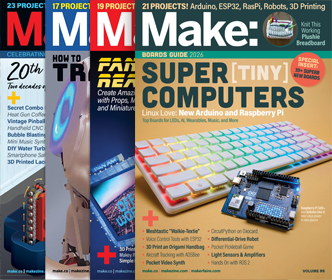Maker Faire Yearbook 2023
Projects
Lidar a basso costo
Faire: Rome
Maker: Giorgio Liberini
Bodynodes
Faire: Rome
Maker: Manuel Bottini
The Electronic Jug Band
Faire: Rome
Maker: Rick MacDonald
Mosquito swatter for gamer, low-tech irrigation with auto-filled ollas or porous capsules
Faire: Rome
Maker: Laurent Muzellec
Sport-graf
Faire: Rome
Maker: IIS Edoardo Amaldi Roma
Opening Technologies for Smart Communities
Faire: Rome
Maker: WeMake S.r.l.
Precious Plastic Torino
Faire: Rome
Maker: ivan martini
SmartBreak
Faire: Rome
Maker: IISS "COLAMONICO-CHIARULLI"
Ternary Computer System
Faire: Rome
Maker: Claudio La Rosa
Wi-Fi Enabled Stratum-1 GNSS Time Server Built From Scratch
Faire: Rome
Maker: Cristiano Monteiro
Light Wheel by Oz Officine Zero
Faire: Rome
Maker: Oz Officine Zero S.c.a.r.l.
Social and Autonomous robots: the MARRtino family
Faire: Rome
Maker: Fabio Ferrarin
OpenPipes Revolutionizes the DIY Pipe Organs
Faire: Rome
Maker: OpenPipes
Home: Argentina
PlasticDrawn
Faire: Rome
Maker: Martino Colucci
Erogatore mangimi solidi e liquidi per volatili.
Faire: Rome
Maker: IIS Tito Sarrocchi
Bracelet Maker — Robotics Toy Made With Girls In Mind
Faire: Rome
Maker: Haptic Synaptic
Arduino-based organ perfusion system.
Faire: Rome
Maker: IRCCS Policlinico S.Martino
PicoFlutter – Wearable for Learning Electronics
Faire: Rome
Maker: Alexandra Covor
CORTEX AUTOMATIONS
Faire: Rome
Maker: luca cortelli
nanosaur
Faire: Rome
Maker: Pizza Robotics
Circle Fermenter – Feeding communities
Faire: Rome
Maker: Matteo Cappellari
Carbonium – LISA
Faire: Rome
Maker: Carbonium
BirdWatch AI – Embedded Bird Watching Solution with TensorFlow
Faire: Rome
Maker: Enrico Stulin
Parko: Sustainable Smart Parking Solution
Faire: Rome
Maker: Khaled Atef Megahed




























